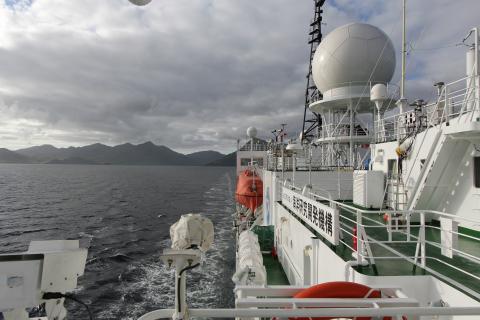Japanese research vessel RV Mirai departed Dutch Harbor northbound for her annual Arctic research mission 31 September. I am onboard once again as Ice Navigator to provide Captain Kan Matsuura and Chief Scientist Jun Inoue support in operating in and near ice. We passed through the Bering Strait on the evening of 02 September and began dedicated observations with a CTD rosette cast off Little Diomede Island.
Mirai voyage MR14-05 is predominantly focused on meteorology, primarily the study of Polar Lows. The first step is the collection met data in the Arctic from areas where no or very few observations have been made before. The data will be shared amongst the participating agencies near real time and incorporate in near term weather mapping and and forecasting. More in depth analysis will follow with the goal of improving prediction of extreme weather events that are often associated with Polar Lows and to improve sea ice forecasts. Concurrent with the met observations, water column sampling will continue. Scientist Shigeto Nishino who was Chief Scientist onboard last year will lead that portion of the research program.
The international meteorological mission coined MOSAiC is coordinated to run from 04 to 24 September. As far as possible data observations will be shared real time between the seven participating stations of 5 nations. The observation points will include land-based stations at Eureka and Alert in Canada, and Norway’s Ny Alesund (each conducting 4 radiosonde launches/day), Canada’s CCGS Amundsen (2 radiosonde launches/day but off line), Germany’s Polarstern (1 radiosonde launch/day), Sweden’s Oden (4 radiosonde launches/day) and Mirai (8 radiosonde launches/day). Mirai has just completed an update and installation of a new weather observation Doppler radar that tremendously improves the quality of data collected onboard. Occasionally a NASA C-130 aircraft will do observations to add to the mix.
Mirai will focus observations on a fixed point in the vicinity of 76º30’N 174º30’W in the open waters of the Chukchi Sea. Each day the ship will come off centre to do water column sampling to the north, south, east and west of that station.
The exact position of the fixed point will depend on ice conditions and that’s where the Ice Navigator becomes a valuable part of the team. As RV Mirai continued north as Ice Navigator I have been receiving ice information from Martech Polar ashore and assessing the changing ice conditions. The present we will transit around the tongue of ice that still extends southwestward from the pack blocking a direct northerly course to our fixed point.
Today we are in open water tomorrow we may encounter our first ice.

